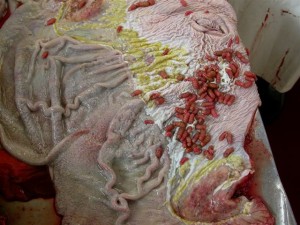Horses: Other Equine Parasites
Uncommon Parasites in Horses that May Occasionally be Detected by FEC tests
- Eimeria leuckarti is a protozoan (not a helminth) which causes coccidiosis, a disease that is not common in horses. You might find an Eimeria oocyst while conducting your FEC test.
Equine Parasites Not Readily Detected by FEC Tests
Some equine parasites (see below) either do not shed eggs in the faeces, or egg numbers cannot be readily determined by a FEC, or the eggs are only shed for short periods in the horse’s life. They are expected to be controlled by default in a properly designed parasite control program which includes an annual treatment with a drug such as praziquantel that is active against tapeworms.
Helminths
Nematodes
• Oxyuris equi (pinworms) – pinworm eggs are rarely observed in faeces because the female pinworm does not discharge her eggs into the faeces, but rather has the unusual habit of migrating out through the horse’s anus and cementing her eggs onto the skin of the anus and its immediate surrounds. Pinworms are a common parasite in horses and cause irritation/itching around the anus.
• Strongyloides westeri (threadworms) – threadworm eggs are mainly observed in foals, being transmitted via the mare’s milk. Threadworms are rarely found in horses older than a few months because of the rapid development of strong immunity in horses by about 6 months of age. Threadworms live in the small intestine of the foal, but the period when the foal sheds threadworm eggs is generally short.
• Habronema spp and Draschia megastoma (stomach worms) – these nematodes are more of a problem as ‘summer sores’ than as internal infection. House and stable flies deposit the larvae on the horse’s muzzle, wounds etc and these larvae, when swallowed by the horse, make their way to the stomach. Eggs are discharged in faeces, but generally only in low numbers.
Platyhelminths
• Anoplocephala perfoliata (tapeworms) – a cestode; they do not lay eggs but segments that contain the eggs break off into the intestinal lumen. The eggs are then released into the faeces as the segment disintegrates. Intermittent segment release (making distribution in the faeces uneven), together with the small numbers of tapeworm eggs and their high specific gravity, makes a diagnosis of tapeworm infection using FEC tests, difficult. Moderate to large tapeworm infestations may be detected using FEC testing, but small burdens are likely to go undetected.
Tapeworms have received growing attention as a cause of colic. When present in high numbers, they can cause significant pathology at the ileocaecal junction in the intestine.
Non-helminths
• Gasterophilus spp (bots; although bots are not helminths, the larval stage is susceptible to anthelmintic treatment) – the bot fly is an insect whose larvae reside in the stomach of the horse. Eggs are not shed in faeces but are laid by the adult female bot fly on the exterior of the horse. The horse licks these off and the larvae rapidly hatch in the oral cavity. After spending about a month in the oral cavity, the larvae proceed to the stomach. Here they develop into a full grown bot, and after about 8-9 months, are passed out in the faeces and develop into the bot fly. Bots do not normally cause clinical disease but can damage gums, causing gingivitis and eventually periodontal disease.
Gasterophilus spp (bots; although bots are not helminths, the larval stage is susceptible to anthelmintic treatment) – the bot fly is an insect whose larvae reside in the stomach of the horse. Eggs are not shed in faeces but are laid by the adult female bot fly on the exterior of the horse. The horse licks these off and the larvae rapidly hatch in the oral cavity. After spending about a month in the oral cavity, the larvae proceed to the stomach. Here they develop into a full grown bot, and after about 8-9 months, are passed out in the faeces and develop into the bot fly. Bots do not normally cause clinical disease but can damage gums, causing gingivitis and eventually periodontal disease.
